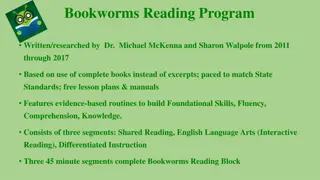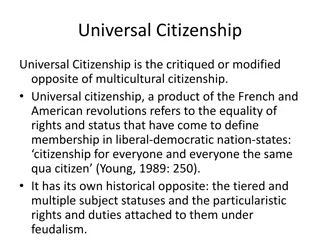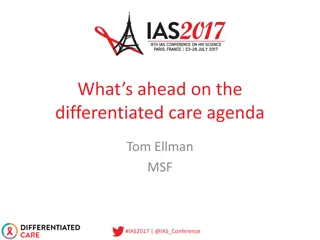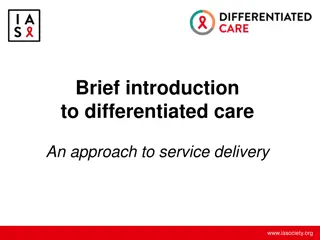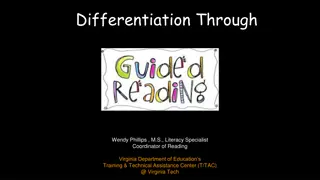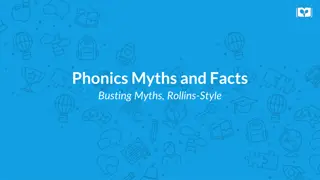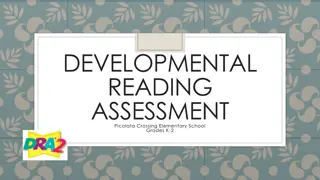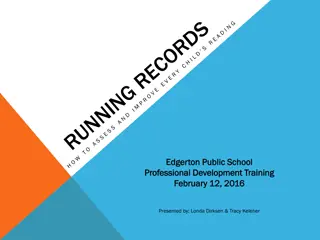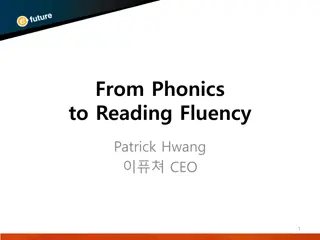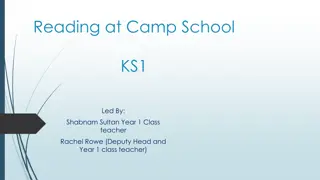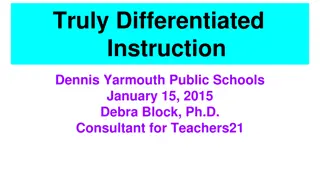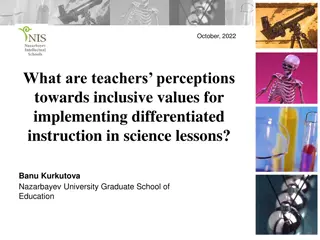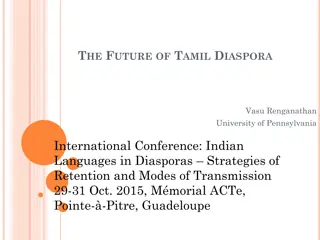Understanding Differentiated Instruction in Reading
This course delves into diverse reading profiles to implement research-based instructional strategies, emphasizing problem-solving and progress monitoring.
- Differentiated Instruction
- Reading Profiles
- Research-Based Practices
- Problem-Solving
- Progress Monitoring
Download Presentation

Please find below an Image/Link to download the presentation.
The content on the website is provided AS IS for your information and personal use only. It may not be sold, licensed, or shared on other websites without obtaining consent from the author. Download presentation by click this link. If you encounter any issues during the download, it is possible that the publisher has removed the file from their server.
E N D
Presentation Transcript
Foundations & Applications of Differentiated Instruction Competency 4 Session 2 Acknowledgements: These materials were prepared by the Florida Center for Reading Research in partnership with the Florida Department of Education, the Just Read Florida! Office, and faculty in the College of Education at Florida State University. The authors would especially like to thank the following faculty and staff for their significant contributions to creating and reviewing materials for this integrated reading endorsement pathway: Mr. Nathan Archer, Ms. Amy Carroll, Dr. Jennifer Gans, Dr. Jennifer Hamilton, Dr. Laurie Lee, Dr. Arzu Leushuis, Ms. Shayla Lightfoot-Brown, Dr. Nicole Patton Terry, Dr. Kevin Smith, and Dr. Kelly Whalon. We acknowledge the authors of the Professional Learning Community materials that support the Foundational Skills to Support Reading for Understanding in Kindergarten Through 3rd Grade*. With those authors' permission, as well as additional resources and materials developed by instructional leaders in Seminole County Public Schools, the same format and five step process for implementing the PLC sessions were utilized for content in Competencies 1 and 2. Permission to reprint or use these materials is required. Inquiries may directed to the Florida Center for Reading Research at fcrr@fcrr.org. *Kosanovich, M. & Foorman, B. (2016). Professional learning communities facilitator s guide for the What Works Clearinghouse practice guide: Foundational skills to support reading for understanding in kindergarten through 3rd grade (REL 2016-227). Washington, DC: U.S. Department of Education, Institute of Education Sciences, National Center for Education Evaluation and Regional Assistance, Regional Educational Laboratory Southeast. Retrieved from http://ies.ed.gov/ncee/edlabs.
Purpose of this Module This course is designed to build a broad knowledge of students with differing reading profiles in order to understand how to apply research- based instructional practices by differentiating process, product and context. This course emphasizes an ongoing, systematic approach to problem solving in which teachers implement and analyze assessments, select and implement appropriate instruction/intervention based on the collected data, and monitor student progress.
What is reading? Denise was stuck in a jam. She worried what her boss would say. What needs to happen to understand this text? Castles, Rastle, & Nation, 2019
Reading is the integration of print and spoken language. It is now well accepted that reading is a language-based skill. Kamhi & Catts, 2012
What is language? Language is a complex and dynamic system of conventional symbols that is used in various modes for thought and communication. Contemporary views of human language hold that: language evolves within specific historical, social, and cultural contexts; language, as rule-governed behavior, is described by at least five parameters phonologic, morphologic, syntactic, semantic, and pragmatic; language learning and use are determined by the interaction of biological, cognitive, psychosocial, and environmental factors; effective use of language for communication requires a broad understanding of human interaction including such associated factors as nonverbal cues, motivation, and sociocultural roles. American Speech Language and Hearing Association (ASHA, 1982)
Parameters of Language Form Content Form Phonology knowledge of how sounds come together to form words Important for phonological awareness or the ability to process, segment, blend and manipulate sounds in words Phonemes = smallest unit of sound Morphemes - smallest unit of meaning Free and Bound Syntax - grammar, conventions for generating meaningful sentences/phrases Use Bloom & Lahey, 1978 Content Semantics knowledge of word meanings and relationships between words Vocabulary knowledge depth and breadth Use Pragmatics rules for using language in conversation/discourse in a variety of settings/contexts; higher level language use including interpreting figurative language, idioms, sarcasm or information not explicitly stated Includes conversational, classroom, narrative and event discourse
Parameters of Language Component Definition Receptive Expressive Phonology Sound system of language, rules that govern sound combinations Process sounds in words Produce sounds in words Semantics Meaning of words and word combinations Understanding word meanings & relationships Use of word meanings & relationships Morphology Structure of words, construction of word forms Understanding grammatical structure of words Use of grammar in words Syntax Rule system governing order combination of words to form phrases, clauses, sentences Sociolinguistic system that patterns use of language in communication Understanding phrases & sentences Use of grammar in phrases & sentences Pragmatics Understanding contextual language cues Use of language in context
So, What is Reading? An active process in which the reader engages with text (written language) to gain information and generate meaning. Spoken language includes cues (e.g., tone, gesture, facial expression) that are missing from text. In written language, these meanings are often inferred from vocabulary, grammar, etc.
Language Development and Reading Development Children who have trouble distinguishing between speech sounds will have trouble analyzing and linking speech to print Children who have limited word knowledge will have trouble understanding text may experience difficulty decoding words not in their vocabulary Children with difficulty with syntactic knowledge can have trouble gaining meaning from sentences Children who have difficulty interpreting and linking sentences in discourse or conversation will have trouble understanding and recalling stories or passages Tunmer & Hoover, 2019
The Simple View of Reading (Gough & Tunmer, 1986) Word Recognition X Language Comprehension = Reading Comprehension Word recognition and listening comprehension are relatively independent of each other, but are both highly correlated with reading comprehension.
Word Recognition (code-focused skills) Mapping sounds to letters and blending those sounds to form words (i.e., alphabetic principle) Opportunities to practice decoding builds knowledge of letter sound patterns in words increasing accuracy and fluency Over time, children become less reliant on phonetic decoding How would you describe the video example using the Simple View of Reading? These skills are influenced by Phonology (speech sounds) Orthography (print symbols or letters) Semantics (word meanings)
Word Recognition Begins with understanding concepts of print, phonological awareness (building to phonemic awareness) Children then begin to apply the alphabetic principle and move from beginning decoding to more advanced decoding Children become increasing fluent in their ability to read words and connected text Rate, accuracy and expression
Comprehension (meaning-focused skills) Good readers form a mental representation of text. This involves complex, higher- level mental processing (thinking, reasoning, imagining, interpreting). Set a purpose for reading Apply knowledge of morphology, syntax and grammar Make inferences Apply vocabulary knowledge Apply content and background knowledge Use knowledge of text structure Monitor understanding This process is the same whether listening to or reading text, and requires understanding at the word, sentence, and discourse levels to generate an accurate representation of text
Discourse Level Processes Reading for meaning is dependent on listening comprehension or generating meaning from spoken words, sentences or discourse Requires word, sentence and discourse levels of understanding to generate a clear, accurate representation of text or situation model Requires application of foundational language skills (vocabulary, grammar) Requires application of advanced linguistic and cognitive processing to integrate world knowledge (domain content and/or interpersonal) with information from text to generate inferences Are active and flexible as mental models are continually refined Involves determining relevant and discarding irrelevant information Knowledge of language and knowledge of the world
Reading Development (K-12) Let s view some videos from Kindergarten through High School As we review the videos, consider the cognitive and linguistic skills the child is applying when reading at this age/grade After viewing a couple of videos, we will describe the developmental progression we observe
Reading Development and the Simple View of Reading Word Recognition X Language Comprehension = Reading Comprehension (Not so simple is it?) From the videos, explain the developmental progression observed using the Simple View of Reading. Important to integrate both decoding and language comprehension instruction from the start Word reading skills Language comprehension skills that support listening comprehension As children become increasingly effective decoders, emphasis on word reading skills decreases
Classifying Reading Difficulties When children are learning to read, reading comprehension is limited to decoding ability When children become better decoders, reading comprehension is increasingly associated with how well the learner comprehends language From the start, effective instruction requires practice and feedback targeting beginning, foundational skills (e.g., sound-letter correspondences, decoding, spelling) while also engaging the learner in more advanced language skills Nation, 2019; Tunmer & Hoover, 2019 Short AIMs Teachable Moments Video: Common Profiles of Reading Difficulties https://haskinsglobal.org/videos/
Dyslexia a difficulty with decoding and spelling fluency which is evident from early school years and persistent over time. Snowling et al., 2020 p. 507 This difficulty also negatively impacts academic performance Can be mild, moderate or severe
Dyslexia Continued Fundamentally, dyslexia is a difficulty learning to decode and spell fluently Difficulty applying newly acquired decoding skills to novel words Dyslexia begins with problems in phonology that make it difficult to map sounds to graphemes (letters or letter combinations that represent a sound) Learning phonological skills improves reading skills indicating that phonological skills are causally related to reading development Problems with phonology manifest in the preschool years before children begin formal reading instruction Individuals with dyslexia often have difficulties in other areas including language oral language problems that can impact language comprehension Snowling et al., 2020
Specific Comprehension Deficit Tends to be a smaller group than learners with word identification difficulties Experience difficulty with reading comprehension despite average or above decoding Often identified later in elementary school when expectations shift from learning to read to reading to learn Adolf & Hogan, 2019; Catts et al., 2006
Meet Alexander Alexander is in the 2nd grade at Sunshine Elementary School. His teacher, Mrs. Hernandez, is concerned because although he has learned several words by sight, he struggles to decode unfamiliar words in text. She has noticed that this seems inconsistent and recently realized that Alexander is very effective using context clues to help him decode. Alexander takes Accelerated Reader tests regularly that require him to read on his own and answer comprehension questions. He consistently scores poorly on these tests. Mrs. Hernandez has also noted that when text is read aloud, Alexander enjoys stories and often comments about books, asks questions and accurately responds to comprehension questions. 1. 2. Describe Alexander s reading performance using the Simple View of Reading. Based on this information, what instructional recommendations would you make to Mrs. Hernandez? What skills should Mrs. Hernandez measure to get a more accurate understanding of Alexander s current reading skills? 3.




